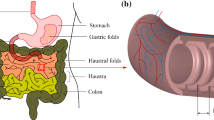Abstract
The development of robotic capsule endoscopes (RCEs) is one avenue presently investigated by multiple research groups to minimize invasiveness and enhance outcomes of enteroscopic procedures. Understanding the biomechanical response of the small bowel to RCEs is needed for design optimization of these devices. In previous work, the authors developed, characterized, and tested the migrating motor complex force sensor (MFS), a novel sensor for quantifying the contact forces per unit of axial length exerted by the myenteron on a solid bolus. This work is a continuation, in which the MFS is used to quantify the contractile strength in the small intestine proximal, middle, and distal regions of five live porcine models. The MFSs are surgically implanted in a generally anesthetized animal, and force data from 5 min of dwell time are analyzed. The mean myenteric contact force from all porcine models and locations within the bowel is 1.9 ± 1.0 N cm−1. Examining the results based on the small bowel region shows a statistically significant strengthening trend in the contractile force from proximal to middle to distal with mean forces of 1.2 ± 0.5, 1.9 ± 0.9, and 2.3 ± 1.0 N cm−1, respectively (mean ± one standard deviation). Quantification of the contact force against a solid bolus provides developers of RCEs with a valuable, experimentally derived parameter of the intraluminal environment.





Similar content being viewed by others
References
Leighton JA, Legnani P, Seidman EG (2007) Role of capsule endoscopy in inflammatory bowel disease: where we are and where we are going. Inflamm Bowel Dis 13:331–337
Upchurch BR, Vargo JJ (2008) Small bowel enteroscopy. Rev Gastroenterol Disord 8:169–177
Phee L, Accoto D, Menciassi A, Stefanini C, Carrozza MC, Dario P (2002) Analysis and development of locomotion devices for the gastrointestinal tract. Biomed Eng, IEEE Trans on 49:613–616
Quirini M, Menciassi A, Scapellato S, Dario P, Rieber F, Ho C-N, Schostek S, Schurr MO (2008) Feasibility proof of a legged locomotion capsule for the GI tract. Gastrointest Endosc 67:1153–1158
Glass P, Cheung E, Sitti M (2008) A legged anchoring mechanism for capsule endoscopes using micropatterned adhesives. Biomed Eng, IEEE Transact on 55:2759–2767
Wang K, Yan G, Ma G, Ye D (2009) An earthworm-like robotic endoscope system for human intestine: design, analysis, and experiment. Ann Biomed Eng 37:210–221
Dodou D, Breedveld P, Wieringa P (2005) Friction manipulation for intestinal locomotion. Minim Invasive Ther Allied Technol 14:188–197
Dodou D, van den Berg M, van Gennip J, Breedveld P, Wieringa PA (2008) Mucoadhesive films inside the colonic tube: performance in a three-dimensional world. J R Soc Interface 5:1353–1362
Harding SE (2003) Mucoadhesive interactions. Biochem Soc Trans 31:1036–1041
Sliker LJ, Wang X, Schoen JA, Rentschler ME (2010) Micropatterned treads for in vivo robotic mobility. J Med Devices 4:041006–041008
Miftahof RN (2005) The wave phenomena in smooth muscle syncytia. In Silico Biol (Gedrukt) 5:479–498
Mortazavi S, Smart J (1995) An investigation of some factors influencing the in vitro assessment of mucoadhesion. Int J Pharma 116:223–230
Hoeg HD, Slatkin AB, Burdick JW, Grundfest WS (2000) Biomechanical modeling of the small intestine as required for the design and operation of a robotic endoscope. In: Robotics and automation, 2000. Proc ICRA’00. IEEE Int Conf, San Francisco, pp 1599–1606
Higa M, Luo Y, Okuyama T, Takagi T (2007) Characterization of the passive mechanical properties of large intestine. Int J Appl Electromagnet Mech 25:595–599
Macagno EO, Christensen J (1980) Fluid mechanics of the duodenum. Annu Rev Fluid Mech 12:139–158
Ciarletta P, Dario P, Tendick F, Micera S (2009) Hyperelastic model of anisotropic fiber reinforcements within intestinal walls for applications in medical robotics. Int J Robot Res 28:1279–1288
Egorov VI, Schastlivtsev IV, Prut EV, Baranov AO, Turusov RA (2002) Mechanical properties of the human gastrointestinal tract. J Biomech 35:1417–1425
Jørgensen CS, Assentoft JE, Knauss D, Gregersen H, Briggs GAD (2001) Small intestine wall distribution of elastic stiffness measured with 500 MHz scanning acoustic microscopy. Ann Biomed Eng 29:1059–1063
Terry BS, Lyle AB, Schoen JA, Rentschler ME (2011) Preliminary mechanical characterization of the small bowel for in vivo robotic mobility. ASME J Biomech Eng 133(9):091010–091017
Samsom M, Smout AJPM, Hebbard G, Fraser R, Omari T, Horowitz M, Dent J (1998) A novel portable perfused manometric system for recording of small intestinal motility. Neurogastroenterol Motil 10:139–148
Clinton Texter E (1968) Pressure and transit in the small intestine. Dig Dis Sci 13:443–454
Miftahof R, Akhmadeev N (2007) Dynamics of intestinal propulsion. J Theor Biol 246:377–393
Miftahof R, Fedotov E (2005) Intestinal propulsion of a solid non-deformable bolus. J Theor Biol 235:57–70
Terry BS, Schoen JA, Rentschler ME (2012) Characterization and experimental results of a novel sensor for measuring the contact force from myenteric contractions. IEEE Transact Biomed Eng
Acknowledgments
The authors wish to acknowledge the Clinical and Translational Research Center at the University of Colorado at Boulder (CTRC) for assistance with the statistical analysis. This work was funded in part by a Junior Faculty Pilot Award from the Colorado Clinical and Translational Sciences Institute (CCTSI). This publication was supported by NIH/NCRR Colorado CTSI Grant no. UL1 RR025780. Its contents are the authors’ sole responsibility and do not necessarily represent official NIH view.
Conflict of interest
Drs. Schoen and Rentschler, and Mr. Terry have no conflicts of interest or financial ties to disclose. No benefits in any form have been or will be received from a commercial party related directly or indirectly to the subject of this manuscript.
Author information
Authors and Affiliations
Corresponding author
Rights and permissions
About this article
Cite this article
Terry, B.S., Schoen, J.A. & Rentschler, M.E. Measurements of the contact force from myenteric contractions on a solid bolus. J Robotic Surg 7, 53–57 (2013). https://doi.org/10.1007/s11701-012-0346-3
Received:
Accepted:
Published:
Issue Date:
DOI: https://doi.org/10.1007/s11701-012-0346-3




